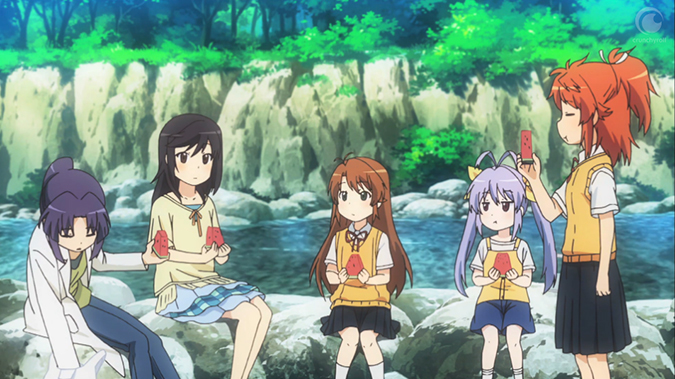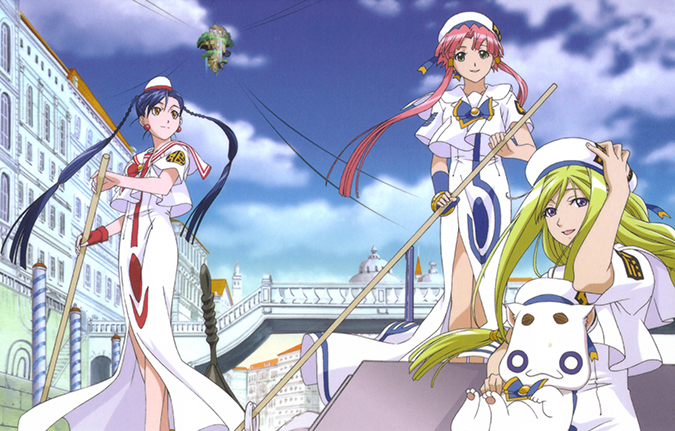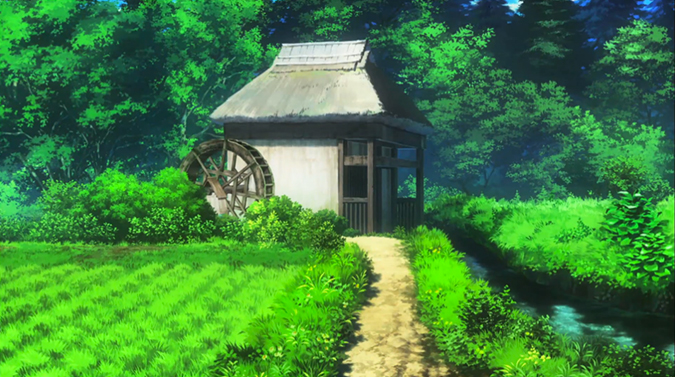I’ve been keeping up with the simulcast of Non Non Biyori this season, and at first glance it’s a bit difficult to explain why. Like most shows in the “slice of life” genre, there isn’t really much of a plot to speak of, and any conflicts that arise among the characters are pretty mundane. If I had to summarize the events of the series thus far, I’d say that it’s about four girls who live in a small rural town and occasionally do stuff. People who say they find slice of life shows dull certainly seem to have a point, so what exactly is the appeal here?
Today’s thrilling adventure: eating watermelons by the river!
Normally, the plot of an anime series can be compared pretty easily to the structure of a novel. Each episode is like a chapter in that it has its own beginning and resolution but ultimately serves to advance the story as a whole. The end goal is to tell one long story that causes the characters and world to change significantly by the end. You could conceivably pick a random episode out of the middle of a series and watch it, but it would make about as much sense to you as reading the fifth chapter of a novel.
By contrast, a slice of life show is structured more like a collection of poetry, short stories, or essays on a particular topic. There’s a central theme or idea that’s being explored, but not necessarily an overarching plot to resolve. Each episode offers a small observation or makes a minor point, but it’s mostly self-contained. Like a single poem in a collection, you could watch one episode and get something out of it, though it might not have the same emotional significance without the rest of the work.
To explore this idea a bit further, I’m going to take a look at one of my favorite slice of life shows, and one I use as a benchmark to judge other works in the genre: Aria. Based on the manga series by Kozue Amano, Aria ran for three seasons and a one-shot OVA. In that time, the viewer follows three apprentice gondoliers as they learn to guide tourists around the canals of a future city modeled after Venice. While there is some semblance of a plot as the heroines work their way up the ranks, the story is only really ever advanced in a handful of episodes. The rest of the series is concerned mainly with getting to know the city and its inhabitants. Without any princesses to rescue or dragons to slay, Aria is free to stop and smell the metaphorical roses. The series is obnoxiously sweet and sentimental, but nearly every episode has an observation to make about friendship, personal growth, or finding beauty in ordinary things. It’s like a collection of poems about what it means to grow up and find your place in the world.
There’s also a sci-fi backstory about terraforming Mars, but that’s not important right now.
Like Aria, there’s no way Non Non Biyori would make a good novel. I’ve been trying to figure out exactly what it’s meant to be instead, and the consistently beautiful background art finally clued me in. Watching Non Non Biyori is like flipping through a book of photos that were taken of a tiny rural town in Japan. The characters wander through a series of snapshots, each one a sentimental glimpse of life lived at a leisurely pace in the middle of nowhere. In many ways, the setting is the star of the show.
Seriously, there’s literally an episode where the characters wander around and take photos of stuff.
I suppose the point here is this: if you look to anime for its epic storylines and frenetic energy, you probably won’t get much enjoyment out of the slice of life genre. If, however, you’re willing to adjust your expectations for a different kind of storytelling, you might have a new experience altogether. When the atmosphere is allowed to upstage the story, the result can be a fascinating, immersive experience.
Kawaii Overthink is written by Paul Jensen. You can follow his ramblings about anime on Twitter.


